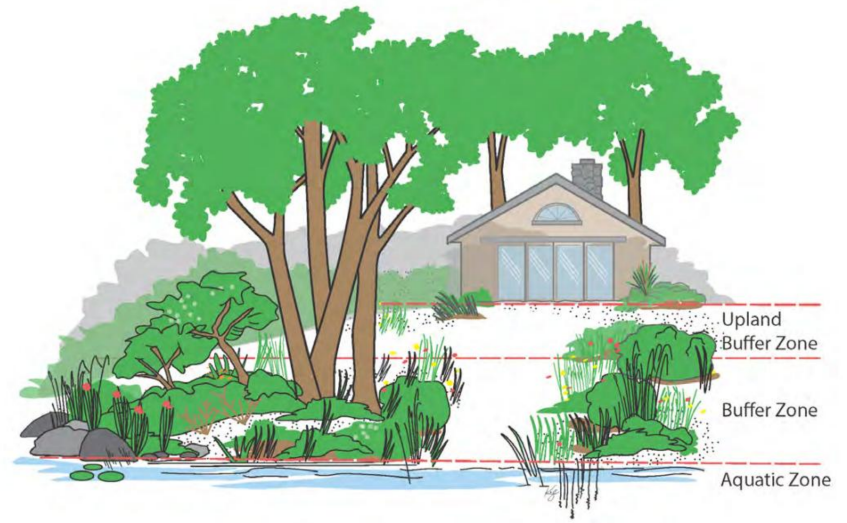 | LOGIN HINTS: |
ShorelAND Stewardship
The quality of the Spider Chain of Lakes depends on how we,
as property owners and visitors, take care of the land near them
Healthy, diverse shorelands provide some of the most effective protection for our lake. Our SCLA Education Committee is undertaking a multi-year project to educate our membership on the steps we can take to maintain or restore our properties to support a healthy lake. This focus supports a key objective in the recently approved Comprehensive Lake Management Plan. We can each play a positive role in maintaining and improving our property’s watershed (the land area that drains to our lakes) to maintain the Spider Chain of Lakes’ water quality. We will focus our efforts on three zones of our waterfront properties. Management activities in each of these zones affect lake health and we will be learning more about best practices for each zone. Importance OF THE Shoreland Stewardship |
Description of the Buffer Zones1. Aquatic Zone: This is the area closest to the water, including the immediate shoreline and shallow waters. It features aquatic plants and grasses that are adapted to wet conditions. These plants help to stabilize the shoreline, reduce erosion, and provide habitat for aquatic organisms. 2. Buffer Zone: Located just beyond the Aquatic Zone, this area includes a mix of shrubs, grasses, and small trees. The vegetation in this zone plays a crucial role in filtering pollutants from runoff, absorbing excess nutrients, and providing habitat for wildlife. 3. Upland Buffer Zone: This zone is furthest from the water and typically consists of larger trees and mixed vegetation. It acts as a secondary barrier, further reducing runoff velocity, trapping sediments, and providing a diverse habitat for terrestrial wildlife. |
|
Why is this program important?
Erosion Control: The vegetation in all three buffer zones helps to stabilize the soil, preventing erosion and reducing sedimentation in the lake, which can harm aquatic habitats.
Water Quality Improvement: These buffers act as natural filters, trapping pollutants such as pesticides, fertilizers, and other chemicals before they can enter the lake. This helps to maintain high water quality and supports a healthy aquatic ecosystem.
Wildlife Habitat: The diverse plant life in the buffer zones provides food, shelter, and breeding grounds for a wide range of wildlife, from aquatic organisms to birds and mammals. This enhances biodiversity and promotes a balanced ecosystem.
Aesthetic and Recreational Benefits: Well-maintained buffer zones enhance the natural beauty of the lakeshore, providing scenic views and contributing to the overall enjoyment of the lake by residents and visitors.
By implementing and maintaining these buffer zones, shoreland stewards can significantly contribute to the health and sustainability of the Spider Chain of Lakes, ensuring that these valuable ecosystems remain vibrant and resilient for future generations.
Where does this program run?
My Shoreline Week:
My Shoreline Week has been an SCLA event since 2013. We ask all SCLA members to pay attention to how your property may either promote a healthy lake or detract from it. A recent theme was “Trust the Buffer.” We asked all members to assess their waterfront to see if they met the 35 foot buffer setback requirement from the ordinary high-water mark. We distributed flyers at various locations to highlight this event.
The best line of defense to preserve the quality of lakes is to maintain a 35 foot natural vegetative buffer to the shoreline. And, in Wisconsin, it's the law:
"To protect water quality, fish and wildlife habitat and natural scenic beauty and to promote preservation and restoration of native vegetation, the county ordinance shall designate land that extends from the ordinary high water mark to a minimum of 35 feet inland as a vegetative buffer zone and prohibit removal of vegetation in the vegetative buffer zone..."----Wisconsin Administrative Code NR 115.05 |
When does this program run?
Check the SLCA Events calendar for the next My Shoreline Week event.
How does this program run?
Best Practices to Improve Habitat and Water Quality:
Wisconsin Healthy Lakes & Rivers suggests five best practices to improve habitat and water quality on shoreland properties. To learn more about each best practice, click on this link.
- Fish Sticks
Create fish and wildlife habitat. Fish sticks are feeding, breeding, and nesting areas for all sorts of critters―from fish to songbirds. They can also prevent bank erosion, protecting lakeshore properties and your lake.
- 350 Ft2 Native Plantings
Native plantings include grasses and wildflowers with shrubs and trees. Choose a template based on your property and interests―from bird/butterfly habitat to a low-growing garden showcasing your lake or river view.
- Diversion
Diversion practices move water to areas where it can soak into the ground instead. Depending on your property, multiple diversions may be necessary.
- Rock Infiltration
Rock infiltration practices fit in nicely along roof drip lines and driveways and provide space for runoff to filter itself. They work best if your soil is sandy or loamy.
- Rain Garden
Rain gardens multi-task. They improve habitat and filter runoff while providing a naturally beautiful view.
